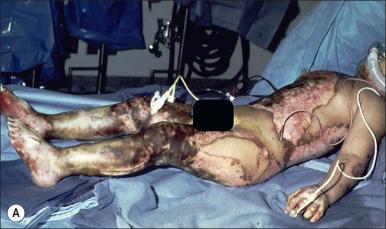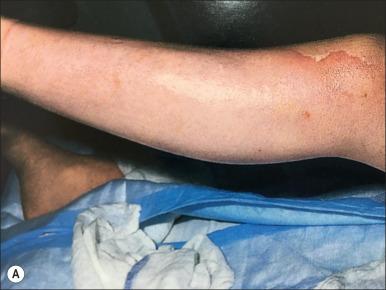Physical Address
304 North Cardinal St.
Dorchester Center, MA 02124
The severity of injury and deformity from burn trauma range from relatively minor to severe. The psychological and social impact of sequelae do not parallel the severity of the deformity; even minor disfigurements can have severe psychologic and social impacts on the patient. Basic concerns common to all burned patients include function, comfort, and appearance. The approach is that of total patient care; it must include all healthcare team members and it is predicated on aesthetic and functional reconstruction. Burn reconstruction is a complex and long process that starts when the patient is admitted in the acute phase and lasts until the patient's expectations have been reached and/or there is nothing more to offer. It is normally a life-long commitment, and, even if there may be no other possibilities to offer at that point, the patient–surgeon relationship still continues. It is preferable, although not imperative, that burn reconstruction be performed in close vicinity to the burn center and that it has the constant support of and coordinated treatment with the multidisciplinary burn team. If this is not the case, good communication with the team referring the patient is desirable.
Preventing and minimizing scarring and deformity in burn patients starts during the acute phase. Reducing the inflammatory and catabolic responses after burn injury using a team approach and early closure of the burn wound is paramount to control wound healing in these patients.
It is preferable that the surgeon managing the acute injury be responsible for later reconstruction. If this is not the case, the reconstructive surgeon should be consulted early on so that the needs for reconstruction enter into the plan of the acute care.
Different procedures are important during the acute phase to minimize later reconstruction. Splints, face masks, silicone gel sheets, early pressure therapy and ambulation, and skeletal traction and fixation are of great importance to produce the best result and avoid future operations ( Fig. 59.1 ).

Burn trauma requires aggressive intervention by rehabilitation services to prevent debilitating deformities. Burn distribution as well as burn depth is a good predictor of rehabilitation outcomes. Prevention of burn deformities includes proper positioning with or without splints, exercise to maintain joint range of motion, maintenance of muscle strength and muscle tone, and early mobilization. All this is true not only for the acute period, but also for the reconstructive period.
Burn patients tend to assume the position of comfort, which is often responsible for deformities that require reconstructive surgery later during the recovery phase ( Box 59.1 ). Thus, positioning in bed is one of the most important ways to prevent deformities ( Box 59.2 ). It is not the responsibility only of rehabilitation services, but of the whole burn team as well. Exercise reduces edema, maintains joint motion and strength, reduces scars, and, in the pediatric patient, maintains development level. Ambulation can begin as soon as the patient is deemed medically stable, with wounds properly dressed and doubly wrapped lower limbs.
Neck flexion
Shoulder protraction
Elbow flexion
Metacarpal extension
Interphalangeal flexion
Wrist flexion
Hip flexion
Knee flexion
Ankle plantar flexion
Maintain straight alignment of the trunk and neck
Neck should be in slight extension
Arms should be elevated in the neutral plane or in line with the glenoid at approximately 15–20 degrees of horizontal flexion and 80 degrees of abduction
Elbow should be in full extension
Hand should be in the intrinsic plus position with the thumb in flexion and abduction
Hips should be in extension and abduction
Knees should be in full extension
Foot should be in neutral position and with 90 degrees or greater dorsiflexion
Prevention by positioning and splinting affects many problems in the care of burned patients. Static and dynamic splints are used for either immobilization or mobilization, respectively. Initially splints are used at all times except for exercise and immediately postop during the immobilization period. As active range of motion increases and is maintained, the protocol changes to night-only splinting. Skeletal traction and fixation also are used on a limited basis to prevent and correct burn scar contracture formation and are always tailored to the patient's needs.
It has been advocated that definitive correction of burn scarring should be delayed for 1 year or longer after healing in the acute period. It is certainly true that unaesthetic and ugly scars mature over time, and, with the effect of pressure and splints, many of them do not require surgery once the acute phase of scar maturation has taken place. Patience is often the best tool of the reconstructive surgeon. However some problems encountered early during the recovery phase must be dealt with and operated on before the golden period of scar maturation is over. In these circumstances it must be absolutely certain that an operation is needed to correct the deformity. Urgent procedures must be planned to correct functions that are not amenable to other treatments, often because time is of the essence. An eyelid release to protect an exposed cornea, correction of distracted or entrapped neurovascular bundles, severe fourth-degree contractures, and severe microstomia fall into this group. Intense rehabilitation, splinting, and pressure therapy are mandatory after correction of these deformities. In some patients deformity may be addressed nonoperatively, but if this approach does not lead to appropriate results, an operation may be considered. In this section fall all burn scar contractures that do not respond to rehabilitation and hypertrophic scarring and contractures that prevent the patient from eating, bathing, moving, and performing activities of daily living.
Most of the problems that patients may present are aesthetic ones and scar contractures that, although not prominent, produce great discomfort. Many of these problems disappear in the first 2 years postburn with appropriate care, and these problems benefit most from patience and time. Many important deformities seen a few months post burn improve with time and can be treated with simple or less extensive procedures later ( Fig. 59.2 ).

Many factors other than scar maturation, however, affect the decision of whether to operate on burn scars. Psychologic and socioeconomic factors are very important when making this decision. The patient's mood plays an important role because an unmotivated or depressed patient will not appreciate the procedure as much as a healthy patient. Moreover, operating on such a patient may produce discomfort and discouragement that, eventually, can jeopardize the patient's compliance and prevent further reconstruction. The social status of the patient is also of great relevance. Emotional support received from friends, family, and co-workers is important, as is the patient's economic status. When making a treatment plan, all these particular circumstances need to be taken into account when considering the number of procedures to be done at a time, recovery time, family support in the recovery phase, and what is to be done first.
Burn patients require an intense and good relationship with their surgeon. The relationship is normally a long-lasting one, many times extending to a lifetime. Patients require a surgeon's professional expertise, but also the surgeon's time, a good dose of optimism, and compassion. The initial meeting is one of the most important events in burn reconstruction. A patient presents with a set of complaints that have to be evaluated together with the patient's motivation for surgery and his or her psychologic status. Chief complaints, patient motivation, and expectations are evaluated. Limitations of surgery and any relevant technique are explained, together with the master plan for reconstruction and the order of reconstructive priorities. Photographic workup is extremely important to document the case, assist in definitive preoperative planning, and for documentation. When dealing with long-term scars and burn deformities, different problems may be encountered intraoperatively that might require a complementary technique. These specific issues of burn reconstructive surgery have to be explained in detail to the patient, and the surgeon needs to foresee and include them in the preoperative planning and the informed consent meetings so that unpleasant surprises are not encountered later.
Patients need to be reassured frequently. A burn reconstruction project involves several operations, many clinic visits, and often a long time to make a final assessment. The patient's feelings and impressions must be addressed continuously and any trouble, minor disappointment, or depression detected early on and treated as needed ( Box 59.3 ).
Starts during acute period
Strong patient–surgeon relationship
Development of a “master plan”
Involvement of the burn team using a multidisciplinary approach
Long and staged procedures
Complex and technological implications
Involvement of plastic surgery and aesthetic surgery/medicine techniques
Become a Clinical Tree membership for Full access and enjoy Unlimited articles
If you are a member. Log in here